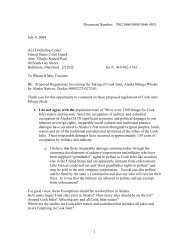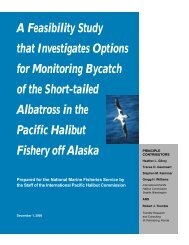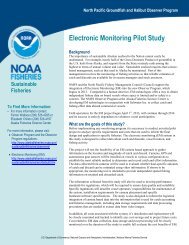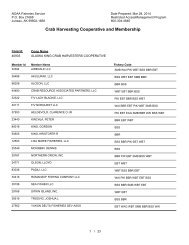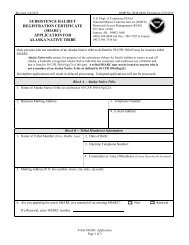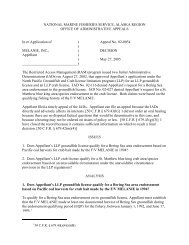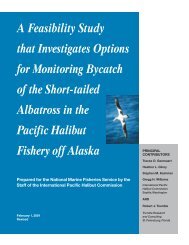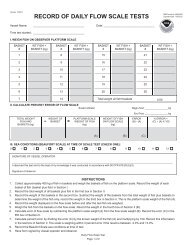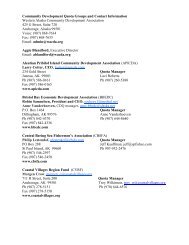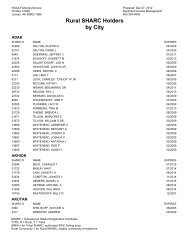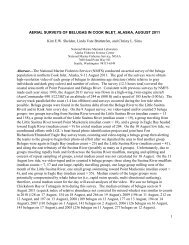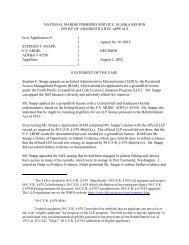Petition to List Lynn Canal Pacific Herring under the Endangered ...
Petition to List Lynn Canal Pacific Herring under the Endangered ...
Petition to List Lynn Canal Pacific Herring under the Endangered ...
You also want an ePaper? Increase the reach of your titles
YUMPU automatically turns print PDFs into web optimized ePapers that Google loves.
<strong>Pacific</strong> herring populations would result in a high degree of gene flow, and thus<br />
little <strong>to</strong> no genetic differentiation among populations.<br />
(S<strong>to</strong>ut et al. 2001).<br />
In <strong>the</strong> Kensing<strong>to</strong>n Gold Project Biological Opinion, NMFS biologists concluded<br />
that <strong>Lynn</strong> <strong>Canal</strong> <strong>Herring</strong> population is probably distinct from o<strong>the</strong>r <strong>Pacific</strong> <strong>Herring</strong> in<br />
Sou<strong>the</strong>ast Alaska.<br />
<strong>Herring</strong> populations, or s<strong>to</strong>cks, are scattered across <strong>the</strong> region from <strong>Lynn</strong> <strong>Canal</strong> <strong>to</strong><br />
Prince of Wales Island, with <strong>the</strong> main spawning concentrations occurring in <strong>the</strong><br />
vicinities of Ketchikan, Craig, Frederick Sound, Sitka, and Auke/Berners Bays<br />
(Skud 1959). Population research conducted in sou<strong>the</strong>ast Alaska and Prince<br />
William Sound suggests that regional herring s<strong>to</strong>cks are comprised of multiple,<br />
distinct subpopulations, or races, which are part of a larger regional<br />
metapopulation, with potential recruitment occurring between subregions<br />
(Rounsefell and Dahlgren 1935, Skud 1959, Brown and Norcross 2001).<br />
Recent genetic analysis of satellite mi<strong>to</strong>chondrial DNA loci from 65 <strong>Pacific</strong><br />
herring sampling locations in British Columbia, sou<strong>the</strong>ast Alaska and Washing<strong>to</strong>n<br />
state found herring spawning in Sou<strong>the</strong>ast Alaska <strong>to</strong> be distinct from those<br />
spawning fur<strong>the</strong>r south in <strong>the</strong> Queen Charlotte Islands (Beacham et al. 2001).<br />
There was little evidence of genetic substructure among <strong>the</strong> herring s<strong>to</strong>cks<br />
examined, but for locations where genetically distinct populations were identified,<br />
differences in timing of spawning was <strong>the</strong> main isolating mechanism and<br />
geographic isolation of <strong>the</strong> spawning population was thought <strong>to</strong> have an effect in<br />
maintaining genetic distinctiveness of <strong>the</strong> spawning population.<br />
Applying <strong>the</strong> metapopulation model (Levins 1970) <strong>to</strong> sou<strong>the</strong>ast Alaska herring<br />
s<strong>to</strong>cks, it is probable that <strong>the</strong> viability of <strong>the</strong> <strong>Lynn</strong> <strong>Canal</strong> subpopulation that<br />
spawns in and around Berners Bay will indirectly impact <strong>the</strong> viability of o<strong>the</strong>r<br />
sou<strong>the</strong>ast regional herring populations through recruitment, genetic diversity, and<br />
sharing of predation pressures from marine mammal populations in nor<strong>the</strong>rn<br />
sou<strong>the</strong>ast Alaska waters.<br />
(NMFS 2005a: 58-59)(emphasis added).<br />
A. Comparison with <strong>Pacific</strong> <strong>Herring</strong> Populations in <strong>the</strong> Gulf<br />
of Alaska and Bering Sea; Grant and Utter (1984),<br />
O’Connell et al. (1998).<br />
Grant and Utter (1984) determined that <strong>Pacific</strong> <strong>Herring</strong> in <strong>the</strong> Bering Sea are a distinct<br />
“race” separated from all herring <strong>to</strong> south along North America’s west coast.<br />
III



